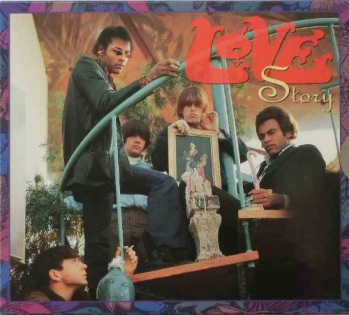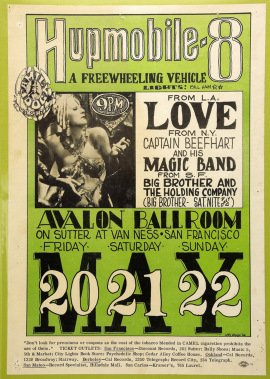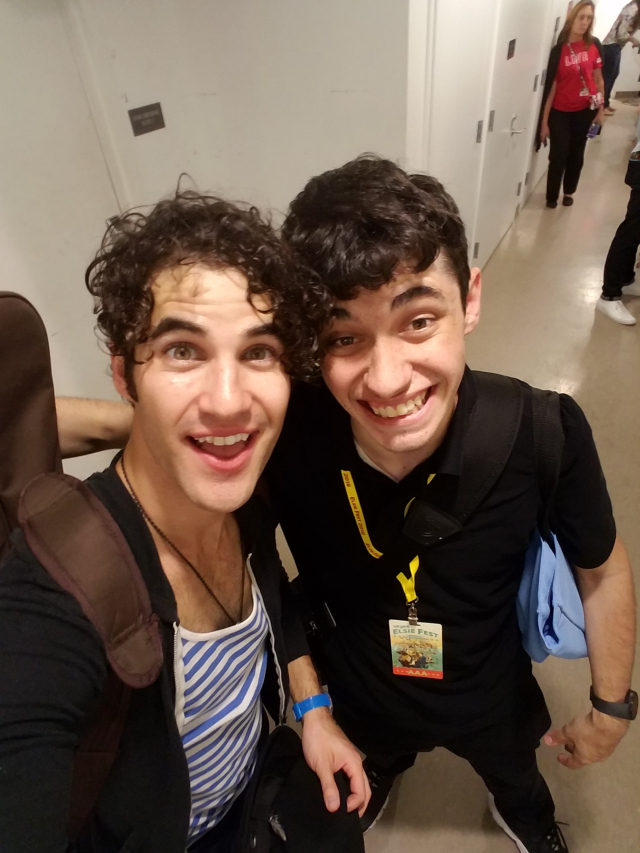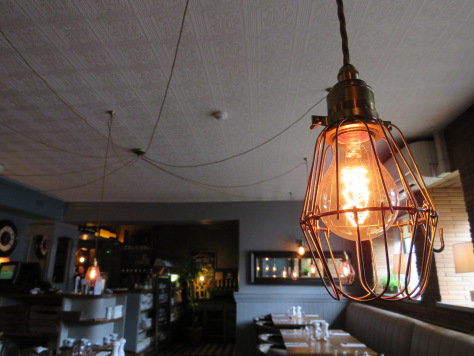

Scanning my recent posts, I can see I’ve been laying on the hot sauce pretty thick lately: xenophobia, white supremacy, Vietnam War, religion… ouch.
Maybe it’s time for a music break.
Earlier this year I profiled four albums on their 50th anniversaries. I picked them because I love good rock music, and these records are some of the best that rock has to offer. They include the debut albums by the Doors, the Velvet Underground, and Pink Floyd, plus that perennial list-topper, the Beatles’ SGT. PEPPER’S LONELY HEARTS CLUB BAND.
Now, I’d like to review a record that is far less popular than PEPPER. It’s not nearly as influential, either. But I consider the music just as good, if not better. It’s strange that so few people know about it.
The record is FOREVER CHANGES by a band called Love. It was released on November 1, 1967.
Sixties-era rock critics, who are getting fewer each year, justly regard Love as one of the great West Coast bands, right there with the Beach Boys, Byrds, Doors, and Grateful Dead. But for the past 50 years, Love has been all but ignored on American FM radio – where most American rock fans get their music. Like certain American jazz and blues artists forgotten in their homeland, Love is more popular outside of the states. And since the Rock and Roll Hall of Fame appears to show no interest in this great band, it’s up to cultists like me to spread the word.
Much of Love’s latter-day fame rests on the band’s third album, FOREVER CHANGES, considered by those in the know a psychedelic masterpiece. I’ll attempt to review it here, but I should probably first offer some biography, and (try to) explain why I love Love, from their evocative name to their unique mix of music and words.
***
Love was formed in Los Angeles in 1965. They were originally called the Grass Roots, until another (less talented) band stole that name. Led by an African-American named Arthur Lee, a former record producer who had worked with Jimi Hendrix when Hendrix was still “Jimmy,” Love was the first integrated rock band (Butterfield Blues Band was also mixed-race, but their music was closer to urban blues than rock).
Love was the first rock band signed to Elektra Records, a label previously known for its impressive roster of folk artists. In 1965-66, Love was one of the most popular bands on L.A.’s Sunset Strip. They performed at hole-in-the-wall clubs like Brave New World and Bido Lito’s, and crowds queued in the street to get in to see them. Neil Young (then in Buffalo Springfield) was a fan, and Jim Morrison cited Love as one of his favorite bands. Morrison later co-opted Arthur Lee’s brooding, punkish singing style.
Love’s first eponymous album included one of the first versions of the garage-band standard “Hey Joe,” as well as one of the first anti-drug songs, “Signed D.C.,” about the band’s original drummer, who was often too strung out to make gigs. The record also included a cover of the Burt Bacharach-Hal David song “My Little Red Book,” which Lee had heard via English band Manfred Mann’s version in the movie WHAT’S NEW PUSSYCAT? Lee’s version was less poppy and more sneering, though. Bacharach heard it and, not surprisingly, hated it. (Much, much later, Bacharach collaborated with Elvis Costello. What’s up with that?).
Invited on Dick Clark’s popular music show American Bandstand, Love lip-synced “My Little Red Book” and “Message to Pretty.” For the performance, Lee wore sunglasses with different-colored, polygonal lenses.
The album LOVE featured a strong folk-rock, Byrds-ish sound, but there were also odd splashes of acid and surf. I interviewed two members of Love, at different times, and each admitted this record was merely their club act transferred to the studio. In my opinion, it’s one of the lost treasures of Sixties rock.
The band added a second drummer and a flute/sax player for their second album, DA CAPO, bringing the lineup to seven members. The second side of this LP has another first: a 19-minute sidelong cut, a blues jam called “Revelation” that Love frequently performed live. But the real goodies are on side one: “Stephanie Knows Who,” “Orange Skies,” 7 and 7 Is,” “¡Que Vida!,” “The Castle,” and “She Comes in Colors.”
I have a reputation for being frank, sometimes to my own detriment. I won’t stop now. I’ll frankly say that side one of Love’s album DA CAPO is one of the most perfect sides of music ever recorded (“Orange Skies” and “7 and 7 Is” are alone worth the price of a boxed set). Proto-punk, flamenco, bossa nova, free jazz, bubblegum, lounge, baroque pop, and acid rock all merge seamlessly on these six songs (and the categories”punk,” “lounge,” and “baroque pop” didn’t even exist then). For “She Comes in Colors,” Lee nicked part of the melody of the Rolling Stones song “Lady Jane.” The Stones heard it, then borrowed the lyrics of Love’s song for “She’s a Rainbow.” Trust me when I say “She Comes in Colors” far surpasses either Stones composition.
I could rhapsodize for hours about these six songs, but my stated goal is to review FOREVER CHANGES, so I’ll stop the blubbering. I’ll just say that “7 and 7 Is” became Love’s highest charting song, reaching #33 on the Billboard charts in the summer of ’66. It’s one of the few songs, along with the Surfaris’ “Wipe Out,” where the drums are the lead instrument. It took Lee and drummer Alban “Snoopy” Pfisterer over 40 alternating takes to perfect the turbo-charged drum pattern, which may explain why the song ends with a recording of an actual atomic bomb blast. This song is punk rock with panache, conceived while Johnny Rotten was possibly still listening to the Monkees.
After DA CAPO, Love was right on track. The band had a minor hit. Lee was a colorful and confident frontman, and exceptional songwriter, with an intoxicating aura of danger and strangeness. Guitarist Bryan MacLean was also a talented writer, specializing in well-crafted songs about romantic love, chocolate, and orange skies, a sort of Paul McCartney to Lee’s John Lennon. Love also had the respect of its peers, and was making regular jaunts up the California coast to dazzle Haight-Ashbury stoners at the Fillmore Auditorium and Avalon Ballroom.
Other Los Angeles bands of the 1960s had become, or were becoming, household names: Beach Boys, Byrds, Mamas and Papas, Turtles, Buffalo Springfield, Doors. Arthur Lee and Love were just as talented as any of them.
But several things happened that kept Love locked in the underground:
First, they were unreasonably hostile to interviewers… when they allowed themselves to be interviewed.
Second, leader Lee had already been burned in the record business, and he was afraid of making the wrong moves, to the point where the band was paralyzed, never venturing outside the comfortable confines of the Golden State.
Third, although they’d been invited to perform at the seminal, career-making Monterey Pop Festival, they turned down the offer. (David Crosby of the Byrds acknowledged them while introducing “Hey Joe”).
Fourth, Elektra Records was busy promoting its new act, the Doors, leaving Love to “sit here and rot,” according to bassist Ken Forssi.
And fifth, the band members were squabbling over royalties (Lee had set himself up for the biggest cut). They were also drifting into hardcore drug use.
When it came time to make a third album, as Forssi relates, “They had to find a time when we were not too high, when we could be found, when the studio was available.” At first, the only Love member present in the studio was leader Lee, surrounded by session musicians, including members of the famed Wrecking Crew. When the other four were finally gathered together (at this point, the band consisted of Lee, MacLean, Forssi, lead guitarist John Echols, and drummer Michael Stuart) … and they saw that session players had usurped their roles… they realized what they were about to lose.
Engineer Bruce Botnick remembers tears being shed. Forssi said they finally came to their senses and pulled together one last time to grind out what he called Love’s “white album.”
(As usual, I’ve rambled too long… please stay tuned for side two of my essay, when I’ll discuss the music on that white album, FOREVER CHANGES.






